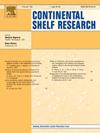Seasonal dynamics and environmental drivers of phytoplankton carbon biomass in the southern yellow sea
IF 2.2
3区 地球科学
Q2 OCEANOGRAPHY
引用次数: 0
Abstract
Phytoplankton carbon biomass serves as a valuable indicator of phytoplankton biomass, playing a crucial role in parameterizing ecosystem models. However, studies on phytoplankton carbon biomass have been quite limited in continental seas, providing limited references for understanding their role in the biogeochemical carbon cycle. In this study, we examined phytoplankton carbon biomass in the SYS during the spring, summer, and fall of 2018, and clarified its characteristics, distribution patterns and controlling factors. Phytoplankton carbon biomass ranged from 2.33 to 84.74 μg C/L in spring, 1.19–1454.25 μg C/L in summer, and 0.01–33.20 μg C/L in fall in the SYS. Diatoms were the most dominant group, contributing 53%, 68%, and 67% to the total phytoplankton carbon in spring, summer, and fall, respectively, followed by dinoflagellates, which contributed 46%, 31%, and 30%. The carbon biomass of diatoms and dinoflagellates exhibited quite distinct correlations with environmental factors. Diatoms exhibited stronger nutrient dependency, whereas no significant correlation was observed between dinoflagellates and nutrients, reflecting the different nutritional strategies of the two groups (strict autotrophy vs. mixotrophy). Compared to cell abundance, carbon biomass revealed a significantly higher proportion of dinoflagellate biomass in the community structure, which is primarily due to the significant interspecies variations in cell volume. Dinoflagellates tend to have larger cell volumes compared to diatoms in the SYS, leading to an underestimation of dinoflagellate proportions when using cell abundance alone. This indicates that simply using cell abundance may lead to cognitive bias in recognizing phytoplankton community structure, and taking carbon biomass into account will provide a more comprehensive understanding.
南黄海浮游植物碳生物量的季节动态及环境驱动因素
浮游植物碳生物量是浮游植物生物量的重要指标,在参数化生态系统模型中起着至关重要的作用。然而,对大陆海浮游植物碳生物量的研究相当有限,对了解其在生物地球化学碳循环中的作用提供的参考有限。本研究对2018年春、夏、秋三季南海区浮游植物碳生物量进行了研究,明确了其特征、分布格局及控制因素。春季浮游植物碳含量为2.33 ~ 84.74 μ C/L,夏季为1.19 ~ 1454.25 μ C/L,秋季为0.01 ~ 33.20 μ C/L。在春季、夏季和秋季,硅藻占浮游植物总碳的比例分别为53%、68%和67%,其次是鞭毛藻,分别为46%、31%和30%。硅藻和鞭毛藻的碳生物量与环境因子的相关性非常明显。硅藻表现出更强的营养依赖性,而鞭毛藻与营养之间没有显著相关性,反映了两组的不同营养策略(严格自养与混合养)。与细胞丰度相比,碳生物量在群落结构中所占比例显著高于鞭毛藻生物量,这主要是由于物种间细胞体积的显著差异。与SYS中的硅藻相比,鞭毛藻往往具有更大的细胞体积,这导致单独使用细胞丰度时低估了鞭毛藻的比例。这表明单纯使用细胞丰度可能导致对浮游植物群落结构的认知偏差,考虑碳生物量将提供更全面的认识。
本文章由计算机程序翻译,如有差异,请以英文原文为准。
求助全文
约1分钟内获得全文
求助全文
来源期刊

Continental Shelf Research
地学-海洋学
CiteScore
4.30
自引率
4.30%
发文量
136
审稿时长
6.1 months
期刊介绍:
Continental Shelf Research publishes articles dealing with the biological, chemical, geological and physical oceanography of the shallow marine environment, from coastal and estuarine waters out to the shelf break. The continental shelf is a critical environment within the land-ocean continuum, and many processes, functions and problems in the continental shelf are driven by terrestrial inputs transported through the rivers and estuaries to the coastal and continental shelf areas. Manuscripts that deal with these topics must make a clear link to the continental shelf. Examples of research areas include:
Physical sedimentology and geomorphology
Geochemistry of the coastal ocean (inorganic and organic)
Marine environment and anthropogenic effects
Interaction of physical dynamics with natural and manmade shoreline features
Benthic, phytoplankton and zooplankton ecology
Coastal water and sediment quality, and ecosystem health
Benthic-pelagic coupling (physical and biogeochemical)
Interactions between physical dynamics (waves, currents, mixing, etc.) and biogeochemical cycles
Estuarine, coastal and shelf sea modelling and process studies.
 求助内容:
求助内容: 应助结果提醒方式:
应助结果提醒方式:


